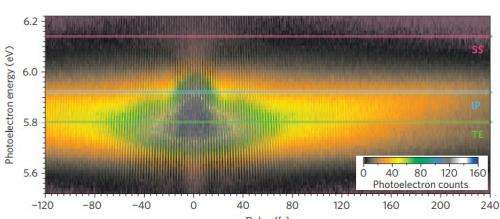Team first to detect exciton in metal

University of Pittsburgh researchers have become the first to detect a fundamental particle of light-matter interaction in metals, the exciton. The team will publish its work online June 1 in Nature Physics.
Mankind has used reflection of light from a metal mirror on a daily basis for millennia, but the quantum mechanical magic behind this familiar phenomenon is only now being uncovered.
Physicists describe physical phenomena in terms of interactions between fields and particles, says lead author Hrvoje Petek, Pitt's Richard King Mellon Professor in the Department of Physics and Astronomy within Kenneth P. Dietrich School of Arts and Sciences. When light (an electromagnetic field) reflects from a metal mirror, it shakes the metal's free electrons (the particles), and the consequent acceleration of electrons creates a nearly perfect replica of the incident light (the reflection).
The classical theory of electromagnetism provides a good understanding of inputs and outputs of this process, but a microscopic quantum mechanical description of how the light excites the electrons is lacking.
Petek's team of experimental and theoretical physicists and chemists from the University of Pittsburgh and Institute of Physics in Zagreb, Croatia, report on how light and matter interact at the surface of a silver crystal. They observe, for the first time, an exciton in a metal.
Excitons, particles of light-matter interaction where light photons become transiently entangled with electrons in molecules and semiconductors, are known to be fundamentally important in processes such as plant photosynthesis and optical communications that are the basis for the Internet and cable TV. The optical and electronic properties of metals cause excitons to last no longer than approximately 100 attoseconds (0.1 quadrillionth of a second). Such short lifetimes make it difficult for scientists to study excitons in metals, but it also enables reflected light to be a nearly perfect replica of the incoming light.
Yet, Branko Gumhalter at the Institute of Physics predicted, and Petek and his team experimentally discovered, that the surface electrons of silver crystals can maintain the excitonic state more than 100 times longer than the bulk metal, enabling the excitons in metals to be experimentally captured by a newly developed multidimensional coherent spectroscopic technique.
The ability to detect excitons in metals sheds light on how light is converted to electrical and chemical energy in plants and solar cells, and in the future it may enable metals to function as active elements in optical communications. In other words, it may be possible to control how light is reflected from a metal.
More information: Paper: "Transient Excitons at Metal Surfaces," DOI: 10.1038/nphys2981
Journal information: Nature Physics
Provided by University of Pittsburgh




















